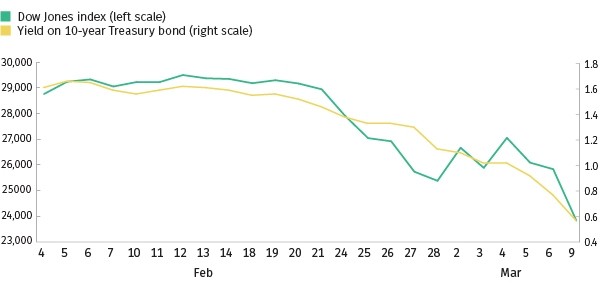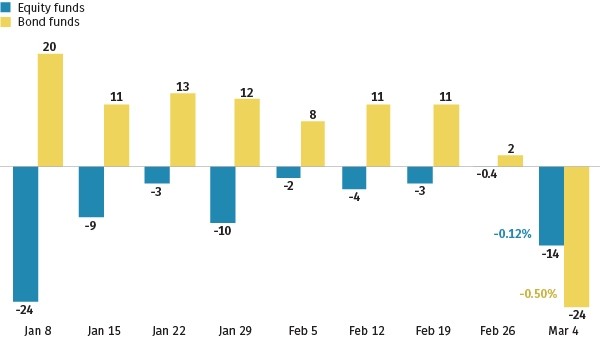
ICI Viewpoints
Mutual Fund Flows in the COVID-19 Crisis

The novel coronavirus disease, or COVID-19, is taking a heavy toll on the world economy—in lives, in the costs of responding, and in lost production and consumption.
Worldwide financial markets reflect this. For example, in the United States, the Dow Jones Industrial Average hit its all-time peak of 29,551 on February 12. Since then, through March 11, it has dropped about 6,000 points, a decline of 20 percent (Figure 1, left scale). Over the same period, yields on 10-year Treasury bonds fell 0.91 percentage points, as investors’ demands for the liquidity and safety of US Treasuries drove up prices. (When bond prices rise, interest rates fall.)
Figure 1
Financial Markets’ Reaction to COVID-19

Source: Federal Reserve Bank of St. Louis
COVID-19 is producing contagion, both literally and figuratively. How are retail investors reacting? Are they panicking, selling out? Or are they staying the course, as during previous financial market epidemics?
It is very early days and we are in uncharted territory. Nevertheless, the available evidence suggests fund investors are staying the course.
To be sure, mutual funds and ETFs have seen outflows. And the outflows have been sizable in dollar terms. For example, during the week ending March 4, equity mutual funds had outflows of $14 billion. Bond funds saw outflows of $24 billion.
Figure 2
Flows to Mutual Funds
Billions of dollars, weekly

Source: Investment Company Institute
But the outflows were small as a percentage of funds’ assets. For the week of March 4, the $14 billion outflow from equity funds totaled just 0.12 percent of their assets as of the end of January. Outflows from bond funds were 0.50 percent of their assets as of the end of January, but still quite modest given the size of recent market movements.
Among bond mutual funds, all types of funds experienced outflows. In past financial market downturns, when credit conditions have deteriorated, high-yield bond funds have tended to see outflows. As Figure 3 shows, high-yield bond funds did account for about one-fourth of the roughly $24 billion in outflows the week of March 4.
But both government bond funds and investment grade bond funds also saw outflows. This is a bit surprising given bond market developments. Yields on government bonds, both Treasury and agency securities, have fallen considerably since February 12, reflecting rising prices and suggesting that funds investing in these securities saw positive returns. In addition, through March 4, yields on investment grade corporate bonds had also dropped, albeit not as sharply as yields on Treasury and agency securities.
We typically expect outflows when fund returns drop. But over the past two weeks, government bond funds (holding primarily Treasury and agency bonds) and investment grade bond funds (which add investment grade corporate bonds to that mix) have seen outflows despite likely positive returns—just the reverse of the normal pattern.
Figure 3
Flows to Bond Mutual Funds
Billions of dollars, weekly

Source: Investment Company Institute
This apparent inversion of the normal pattern could reflect portfolio rebalancing. Increasingly, investors are using products—such as target date and target risk funds, model portfolios, or other asset allocation or rebalancing tools (e.g., robo-advisers)—that are designed to rebalance periodically in light of market conditions. For example, during a period when the stock market falls and the bond market rises—such as the past few weeks—an investor who wants to maintain a portfolio target of 60 percent equity and 40 percent bonds would need to sell a slug of bonds to purchase equities. This kind of rebalancing would tend to help stabilize the financial markets because funds would be selling bonds when they were appreciating and buying stocks that are becoming more of a bargain.
We will be following these trends closely and will get back to readers with updates in forthcoming ICI Viewpoints. We’ll see how these forces play out—but, so far, stock and bond fund investors are staying the course, as they have in every other market incident we have data on.
Sean Collins is Chief Economist at ICI.
